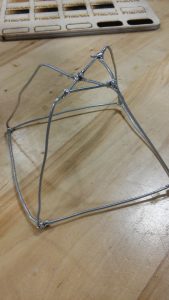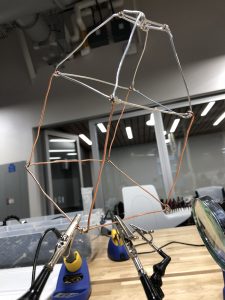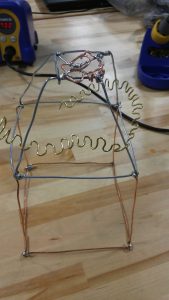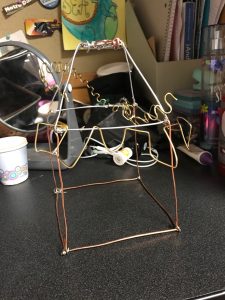We began this project with the idea of using our metal wire to create a four-sided pyramid, with a flat top to support and balance the Dixie cup. Not knowing the geometric superiority of triangles, and therefore a three-sided pyramid, the square pyramid was chosen not only for structure (it’s still a pyramid) but aesthetic preference over triangular pyramids. Jessica began by taking the wires and using the steel first to create the pyramid, knowing that the steel was going to be the strongest of the three wires. Most of the steel was used with only a few pieces of it left to be incorporated elsewhere (such as later on one of the bottom corners of the copper extensions).
One length of two-foot, steel wire created the entire square base and two of the four pyramid edges, on opposite sides. Other pieces of steel wire were cut to create the other two edges and the square platform on which the cup would sit. By far, twisting the wires around each other at corners or other joining points before soldering the joint was sturdier that simply relying on soldering to join any two pieces of wire.
After the top pyramid was made, and we came to the realization that it was not six inches off the ground, so Peri proceeded to add an additional cube beneath the pyramid to elevate it. To create the cube, she cut four pieces of copper wire that were of identical lengths. The copper and the brass were similar in flexibility and strength so, although we used copper, there was not too much of a motivation behind it. We also had used all the steel up at that point. With each cut copper wire, Peri bent the tops of each one to create an initial joint between the the pyramid and the piece of copper. From there, each piece was soldered. She found it easier to solder the copper to the steel, but based upon class discussion, that feeling was an anomaly. Afterwards, the base of the cube was made by bending one long piece of wire and then connecting with only one joint. We thought that by keeping the wir e fully intact, it would be stronger. There were no joints to break so it would have greater structural integrity. From there, the square base had to be attached to the wire by being soldered to the pyramid. Once again, the tips of the wire were bent to created loops, creating initial joints between the two objects. They were then soldered and the cube was complete. The pyramid’s base is slightly smaller than that of the cube; this was intentional so that the pressure would not go straight down the object. The pressure was pushed slightly out. However, if the cube’s base was too large, then the pressure from the pyramid and the coins on top would push outwards, and most likely would cause the structure to collapse.
e fully intact, it would be stronger. There were no joints to break so it would have greater structural integrity. From there, the square base had to be attached to the wire by being soldered to the pyramid. Once again, the tips of the wire were bent to created loops, creating initial joints between the two objects. They were then soldered and the cube was complete. The pyramid’s base is slightly smaller than that of the cube; this was intentional so that the pressure would not go straight down the object. The pressure was pushed slightly out. However, if the cube’s base was too large, then the pressure from the pyramid and the coins on top would push outwards, and most likely would cause the structure to collapse.
After the copper platform was made and attached to the base of the steel pyramid, we found that, though we had the entirety of brass left and only a little bit of copper, the structure itself didn’t really need anymore structural support. The rest of the copper was reincorporated to the curved design on top. It added aesthetic whimsy, but it also helped to balance the unevenness of the steel wire surface that would be directly supporting the Dixie cup; we knew that balance was going to be important to the challenge. If the structure couldn’t balance two Dixie cups-worth of pennies, it could never have p roved that it could support the weight of two Dixie cups-worth of pennies. In using the spare copper, we also experimented with tight curling around the steel rim but found that it took too much effort and time for too little effect, and in the process of curling the copper tightly, it did break.
roved that it could support the weight of two Dixie cups-worth of pennies. In using the spare copper, we also experimented with tight curling around the steel rim but found that it took too much effort and time for too little effect, and in the process of curling the copper tightly, it did break.
Then all we had left was the brass. Since the support wasn’t needed structurally, yet all the wire still had yet to be used, the brass wire was incorporated completely aesthetically, being bent and folded around or soldered to the rest of the structure. Working with the brass, it became very clear that it did not want to be soldered to the other metal, specifically the steel. It became apparent that the soldering iron was sometimes difficult to use, but we managed to make it work. Using the soldering iron to combine different types of metals was something we learned to overcome, and we figured out how to bend the wire and connect it in ways that did not need to be soldered. The wire structure has a relatively clean aesthetic. There are no bars or structural supports that blocks the viewer’s gaze through the object. Because it is so open, the pennies on top of the object appear to be effortlessly placed there; they seem to be almost floating on top. The brass wire gives movement to the otherwise static piece. It creates a juxtaposition between the solid structure of the pyramid and the whimsy of the bent wire.
In retrospect, we would have liked to create our wire structure with three faces instead of four. After the discussion in class, we came to the real ization that threes are stronger than four. However, our wire structure was still strong and was able to hold all the pennies. It did not wobble and was sturdy. In addition, the coins were seven inches off the ground, marginally exceeding the height requirement. Another possible modification that could be made if this had to be done again would be to add some wire bars around where the base of the Dixie cup sits. This would ensure that the cup would not fall out so we would not have to rely too much on balancing the cup on top. However, we are satisfied with the function and the aesthetic of the structure.
ization that threes are stronger than four. However, our wire structure was still strong and was able to hold all the pennies. It did not wobble and was sturdy. In addition, the coins were seven inches off the ground, marginally exceeding the height requirement. Another possible modification that could be made if this had to be done again would be to add some wire bars around where the base of the Dixie cup sits. This would ensure that the cup would not fall out so we would not have to rely too much on balancing the cup on top. However, we are satisfied with the function and the aesthetic of the structure.

